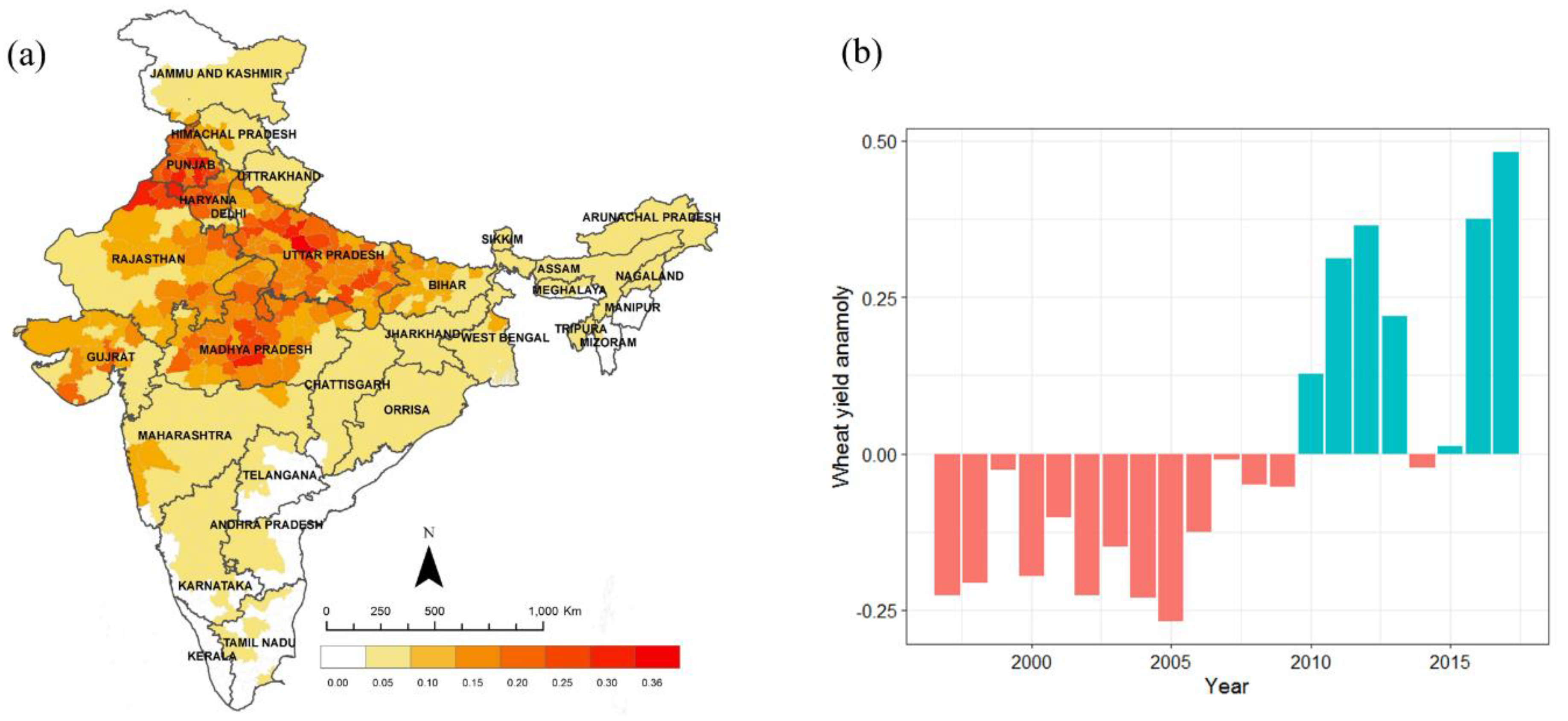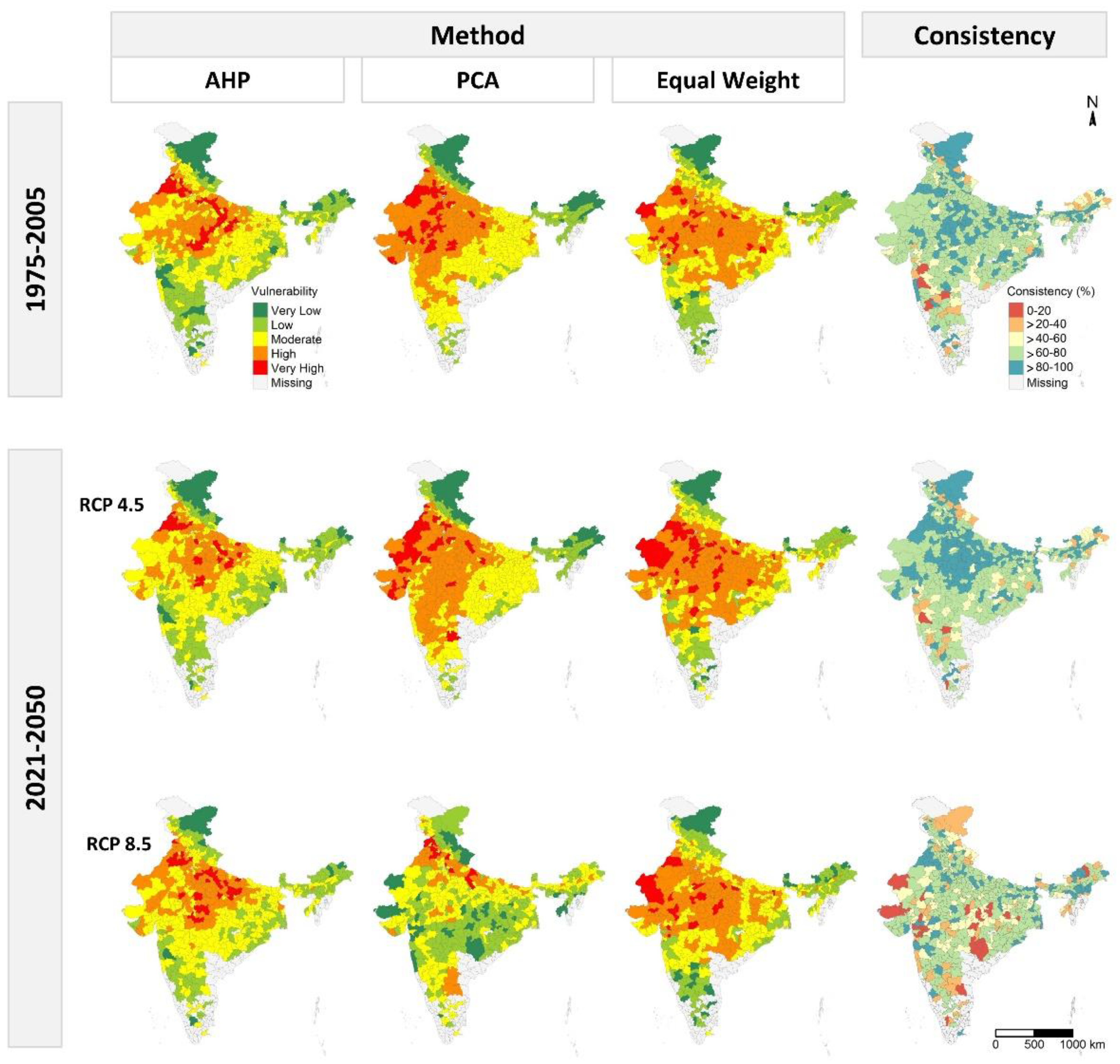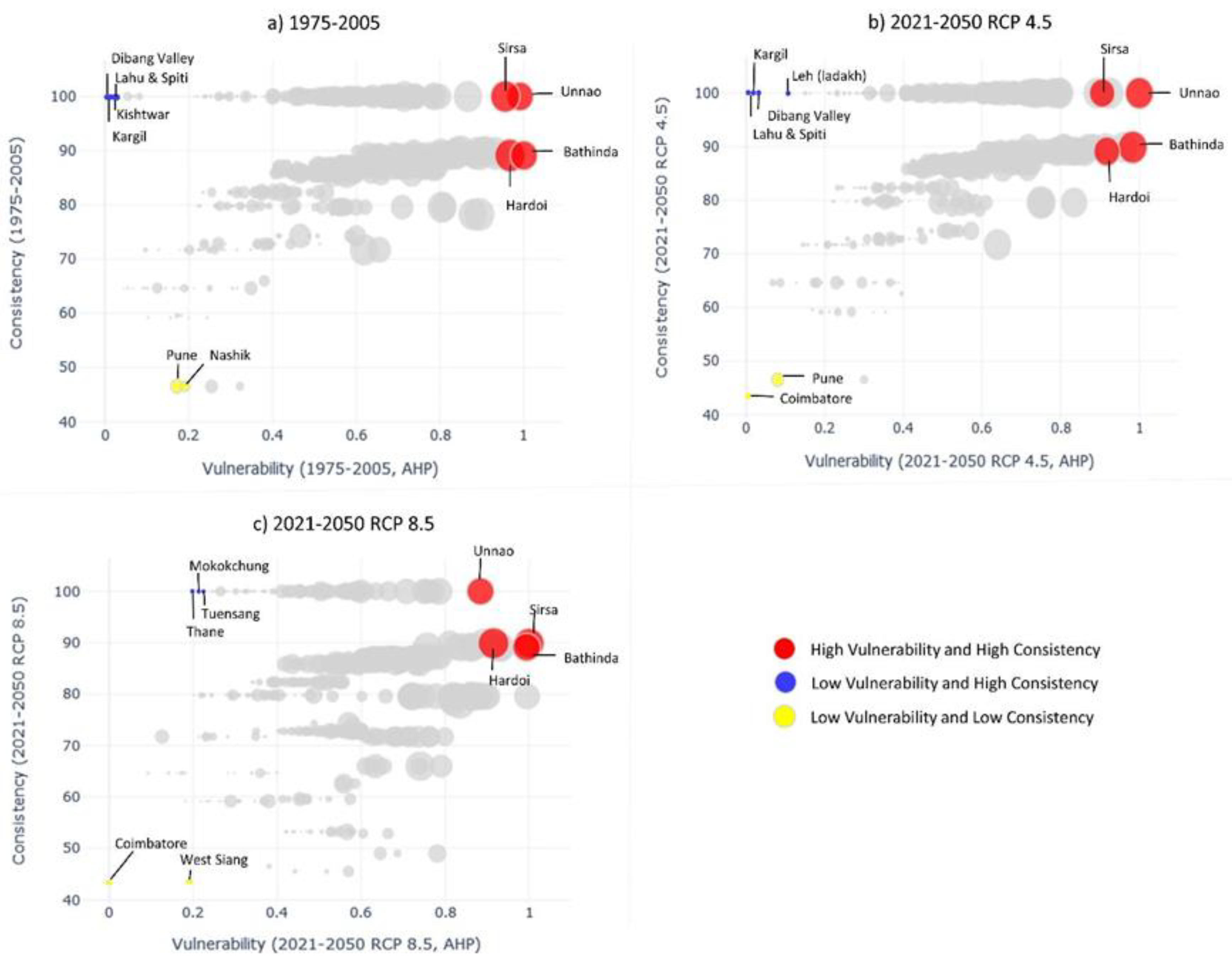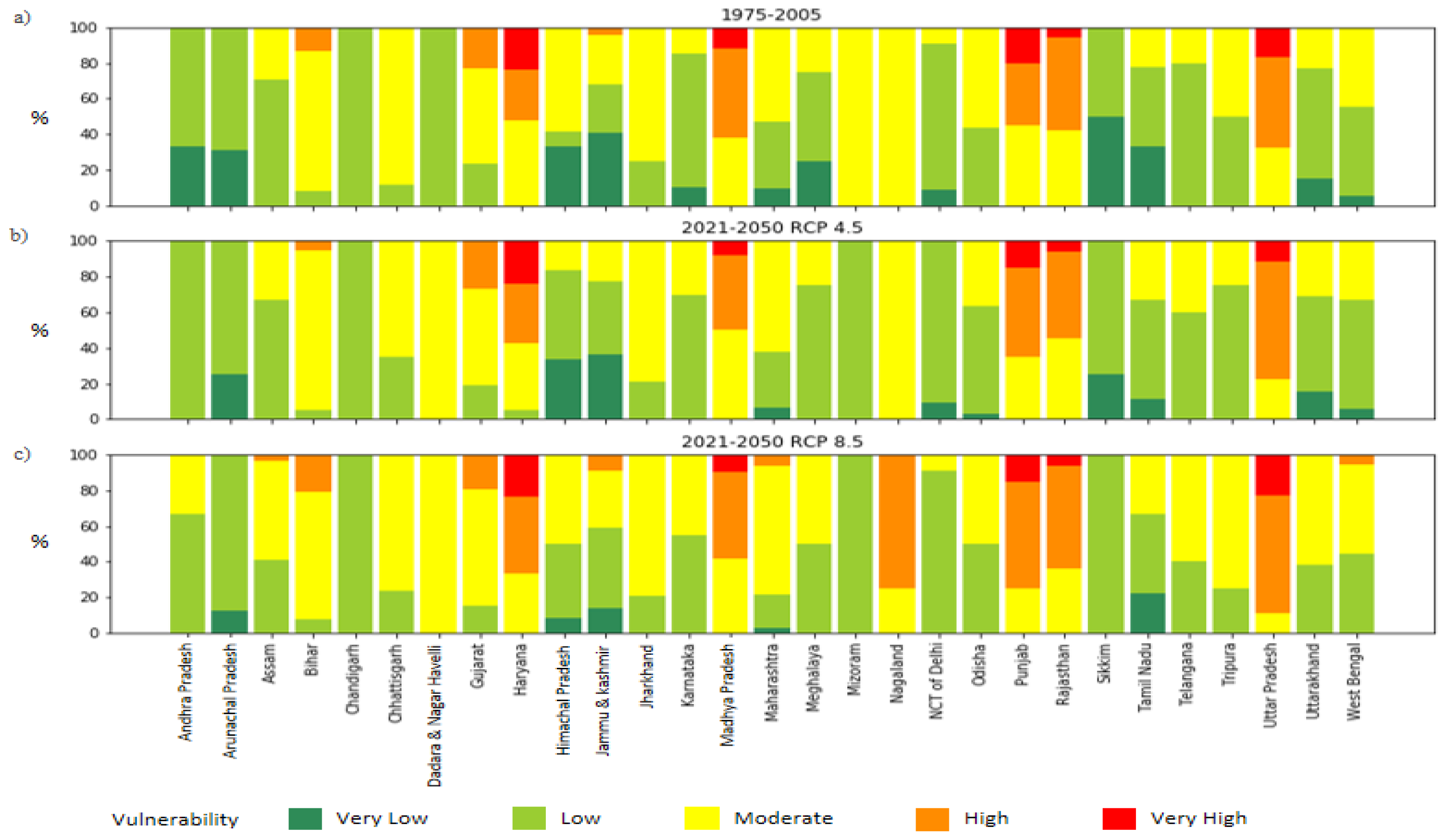Consistency in Vulnerability Assessments of Wheat to Climate Change—A District-Level Analysis in India
Abstract
1. Introduction
2. Study Area
3. Data and Methodology
3.1. Vulnerability Components and Indicators
3.2. Methodology
3.2.1. Assessing Vulnerability
3.2.2. Analyzing Consistency of Vulnerability
4. Results
4.1. Spatial Distribution of Wheat Crop Vulnerability
4.2. Consistency across Weighting Methods in Assessing Wheat Crop Vulnerability
5. Discussion
6. Conclusions
Supplementary Materials
Author Contributions
Funding
Conflicts of Interest
References
- USDA Foreign Agricultural Service. Available online: http://www.fas.usda.gov (accessed on 23 September 2020).
- Kennedy, D. The importance of rice. Science 2002, 296, 13. [Google Scholar] [CrossRef]
- Kumar, S.N.; Aggarwal, P.; Rani, D.S.; Saxena, R.; Chauhan, N.; Jain, S. Vulnerability of wheat production to climate change in India. Clim. Res. 2014, 59, 173–187. [Google Scholar] [CrossRef]
- Farmers’ Portal. Fourth Advance Estimates of Production of Foodgrains for 2017–18. Available online: https://eands.dacnet.nic.in/Advance_Estimate/4th_Adv_Estimates2017-18_Eng.pdf (accessed on 2 August 2020).
- Acharya, S. Food security and Indian agriculture: Policies, production performance and marketing environment. Agricultural economics research review. Agric. Econ. Res. Assoc. 2009, 22, 1–19. [Google Scholar]
- Parayil, G. The Green revolution in India: A case study of technological change. Technol. Cult. 1992, 33, 737. [Google Scholar] [CrossRef]
- Zaveri, E.; Lobell, D.B. The role of irrigation in changing wheat yields and heat sensitivity in India. Nat. Commun. 2019, 10, 1–7. [Google Scholar] [CrossRef]
- Ramadas, S.; Kumar, T.K.; Singh, G.P. Wheat production in India: Trends and prospects. Recent Adv. Grain Crop. Res. 2020. [Google Scholar] [CrossRef]
- Kumar, A.; Singh Poswal, R.; Singh, G.; Kumar Sharma, R.; Singh Saharan, M.; Singh Chhokar, R.; Tyagi, B.; Ramadas, S.; Chand, R.; Sharma, I. Wheat Cultivation in India; Directorate of Wheat Research: Karnal, India, 2020. [Google Scholar]
- Yu, Q.; Li, L.; Braunack, M.; Eamus, D.; Xu, S.; Chen, C.; Wang, E.; Liu, J.; Nielsen, D.C. Year patterns of climate impact on wheat yields. Int. J. Clim. 2013, 34, 518–528. [Google Scholar] [CrossRef]
- Lal, M.; Singh, K.; Rathore, L.; Srinivasan, G.; Saseendran, S. Vulnerability of rice and wheat yields in NW India to future changes in climate. Agric. For. Meteorol. 1998, 89, 101–114. [Google Scholar] [CrossRef]
- Kalra, N.; Chakraborty, D.; Sharma, A.; Rai, H.; Jolly, M.; Chander, S.; Kumar, P.; Bhadraray, S.; Barman, D.; Mittal, R.; et al. Effect of increasing temperature on yield of some winter crops in northwest India. Curr. Sci. 2008, 94, 82–88. [Google Scholar]
- Asseng, S.; Ewert, F.; Martre, P.; Rötter, R.P.; Lobell, D.B.; Cammarano, D.; Kimball, B.A.; Ottman, M.J.; Wall, G.W.; White, J.W.; et al. Rising temperatures reduce global wheat production. Nat. Clim. Chang. 2014, 5, 143–147. [Google Scholar] [CrossRef]
- IPCC. Summary for Policymakers. In Climate Change and Land: An IPCC Special Report on Climate Change, Desertification, Land Degradation, Sustainable Land Management, Food Security, and Greenhouse Gas Fluxes in Terrestrial Ecosystems; Shukla, J., Skea, E., Calvo Buendia, V., Masson-Delmotte, H.-O., Pörtner, D.C., Roberts, P., Zhai, R., Slade, S., Connors, R., Van Diemen, M., et al., Eds.; 2019; In press. [Google Scholar]
- Luo, Q. Temperature thresholds and crop production: A review. Clim. Chang. 2011, 109, 583–598. [Google Scholar] [CrossRef]
- Zhao, C.; Liu, B.; Piao, S.; Wang, X.; Lobell, D.B.; Huang, Y.; Huang, M.; Yao, Y.; Bassu, S.; Ciais, P.; et al. Temperature increase reduces global yields of major crops in four independent estimates. Proc. Natl. Acad. Sci. USA 2017, 114, 9326–9331. [Google Scholar] [CrossRef]
- Aggarwal, P.; Joshi, P.; Ingram, J.; Gupta, R. Adapting food systems of the Indo-Gangetic plains to global environmental change: Key information needs to improve policy formulation. Environ. Sci. Policy 2004, 7, 487–498. [Google Scholar] [CrossRef]
- Mall, R.K.; Singh, R.; Gupta, A.; Srinivasan, G.; Rathore, L.S. Impact of climate change on Indian agriculture: A review. Clim. Chang. 2007, 82, 225–231. [Google Scholar] [CrossRef]
- Boote, K.; Singh, A.K. Implications of global climatic change on water and food security. Water Sec. Clim. Chang. Sust. Dev. 2009, 49–63. [Google Scholar] [CrossRef]
- Rao, C.S.; Gopinath, K.; Prasad, J.; Prasannakumar; Singh, A. Climate resilient villages for sustainable food security in tropical India: Concept, process, technologies, institutions, and impacts. Adv. Agron. 2016, 140, 101–214. [Google Scholar] [CrossRef]
- Basha, S.G.; Kishore, P.; Ratnam, M.V.; Jayaraman, A.; Kouchak, A.A.; Ouarda, T.B.M.J.; Velicogna, I. Historical and projected surface temperature over India during the 20th and 21st century. Sci. Rep. 2017, 7, 2987. [Google Scholar] [CrossRef]
- Shewry, P.R.; Halford, N.G. Cereal seed storage proteins: Structures, properties and role in grain utilization. J. Exp. Bot. 2002, 53, 947–958. [Google Scholar] [CrossRef]
- Triboi, A.-M.; Martres, P.; Girousse, C.; Ravel, C.G.; Triboi-Blondel, A.-M. Unravelling environmental and genetic relationships between grain yield and nitrogen concentration for wheat. Eur. J. Agron. 2006, 25, 108–118. [Google Scholar] [CrossRef]
- Sharma, T.; Vittal, H.; Karmakar, S.; Ghosh, S. Increasing agricultural risk to hydro-climatic extremes in India. Environ. Res. Lett. 2020, 15, 034010. [Google Scholar] [CrossRef]
- Martres, P.; Wallach, D.; Asseng, S.; Ewert, F.; Jones, J.W.; Rötter, R.P.; Boote, K.J.; Ruane, A.C.; Thorburn, P.J.; Cammarano, D.; et al. Multimodel ensembles of wheat growth: Many models are better than one. Glob. Chang. Biol. 2014, 21, 911–925. [Google Scholar] [CrossRef] [PubMed]
- Füssel, H.-M.; Klein, R.J.T. Climate change vulnerability assessments: An evolution of conceptual thinking. Clim. Chang. 2006, 75, 301–329. [Google Scholar] [CrossRef]
- Huai, J. Integration and typologies of vulnerability to climate change: A case study from Australian wheat sheep zones. Sci. Rep. 2016, 6, 33744. [Google Scholar] [CrossRef] [PubMed]
- Attri, S.D.; Rathore, L.S. Simulation of impact of projected climate change on wheat in India. Int. J. Clim. 2003, 23, 693–705. [Google Scholar] [CrossRef]
- Pathak, H.; Wassmann, R. Quantitative evaluation of climatic variability and risks for wheat yield in India. Clim. Chang. 2008, 93, 157–175. [Google Scholar] [CrossRef]
- Aggarwal, P.; Kumar, S.; Pathak, H. Impacts of Climate Change on Growth and Yield of Rice and Wheat in the Upper Ganga Basin; WWF: New Delhi, India, 2010. [Google Scholar]
- Fraser, E.D.; Simelton, E.; Termansen, M.; Gosling, S.N.; South, A. Vulnerability hotspots: Integrating socio-economic and hydrological models to identify where cereal production may decline in the future due to climate change induced drought. Agric. For. Meteorol. 2013, 170, 195–205. [Google Scholar] [CrossRef]
- Moorthy, A.; Buermann, W.; Rajagopal, D. The Impact of Climate Change on Crop. Yields in India from 1961 to 2010; State Centre on Climate Change: Himachal Pradesh, India, 2012. [Google Scholar]
- Liu, B.; Asseng, S.; Müller, C.; Ewert, F.; Elliott, J.; Lobell, D.B.; Martres, P.; Ruane, A.C.; Wallach, D.; Jones, J.W.; et al. Similar estimates of temperature impacts on global wheat yield by three independent methods. Natl. Clim. Chang. 2016, 6, 1130–1136. [Google Scholar] [CrossRef]
- Sendhil, R.; Jha, A.; Kumar, A.; Singh, S. Extent of vulnerability in wheat producing agro-ecologies of India: Tracking from indicators of cross-section and multi-dimension data. Ecol. Indic. 2018, 89, 771–780. [Google Scholar] [CrossRef]
- Gupta, R.; Somanathan, E.; Dey, S. Global warming and local air pollution have reduced wheat yields in India. Clim. Chang. 2016, 140, 593–604. [Google Scholar] [CrossRef]
- Sonkar, G.; Mall, R.K.; Banerjee, T.; Singh, N.; Kumar, T.L.; Chand, R. Vulnerability of Indian wheat against rising temperature and aerosols. Environ. Pollut. 2019, 254, 112946. [Google Scholar] [CrossRef]
- Wiréhn, L.; Danielsson, Å.; Neset, T.-S.S. Assessment of composite index methods for agricultural vulnerability to climate change. J. Environ. Manag. 2015, 156, 70–80. [Google Scholar] [CrossRef] [PubMed]
- Parker, L.; Bourgoin, C.; Martinez-Valle, A.; Laderach, P. Vulnerability of the agricultural sector to climate change: The development of a pan-tropical climate risk vulnerability assessment to inform sub-national decision making. PLoS ONE 2019, 14, e0213641. [Google Scholar] [CrossRef] [PubMed]
- IPCC; Smith, J.; Schellnhuber, H.; Mirza, M. Vulnerability to Climate Change and Reasons for Concern: A Synthesis; Cambridge University Press: Cambridge, UK; New York, NY, USA, 2001. [Google Scholar]
- India at a Glance. FAO in India. Food and Agriculture Organization of the United Nations. Available online: http://www.fao.org/india/fao-in-india/india-at-a-glance/en/ (accessed on 24 September 2020).
- Directorate of Wheat Development Ministry of Agriculture. Status Paper on Wheat; Department of Agriculture and Cooperation: Ghaziabad, India, 2016. [Google Scholar]
- Wheeler, T.R.; Von Braun, J. Climate change impacts on global food security. Science 2013, 341, 508–513. [Google Scholar] [CrossRef] [PubMed]
- Allen, S.K.; Burton, I.; Campbell-Lendrum, D.; Cardona, O.D.; Cutter, S.L.; Dube, O.P.; Ebi, K.L.; Handmer, J.W.; Lal, P.N.; Lavell, A.; et al. Summary for policymakers. Manag. Risks Extrem. Events Disasters Adv. Clim. Chang. Adapt. 2012, 3–22. [Google Scholar] [CrossRef]
- IPCC; Parry, O.F.C.; Palutikof, J.P.; Van der Linden, P.J.; Hanson, C.E. (Eds.) Summary for Policymakers. Climate Change 2007: Impacts, Adaptation and Vulnerability. Contribution of Working Group II to the Fourth Assessment Report of the Intergovernmental Panel on Climate Change; Cambridge University Press: Cambridge, UK; New York, NY, USA, 2014; pp. 1–32. [Google Scholar]
- Dunne, J.P.; John, J.G.; Adcroft, A.J.; Griffies, S.M.; Hallberg, R.W.; Shevliakova, E.; Stouffer, R.J.; Cooke, W.; Dunne, K.A.; Harrison, M.J.; et al. GFDL’s ESM2 global coupled climate-carbon earth system models. Part I: Physical formulation and baseline simulation characteristics. J. Clim. 2012, 25, 6646–6665. [Google Scholar] [CrossRef]
- Jena, P.; Azad, S.; Rajeevan, M. Statistical selection of the optimum models in the CMIP5 dataset for climate change projections of Indian monsoon rainfall. Climate 2015, 3, 858–875. [Google Scholar] [CrossRef]
- Adger, W.N. Vulnerability. Glob. Environ. Chang. 2006, 16, 268–281. [Google Scholar] [CrossRef]
- Smit, B.; Wandel, J. Adaptation, adaptive capacity and vulnerability. Glob. Environ. Chang. 2006, 16, 282–292. [Google Scholar] [CrossRef]
- Tate, E. Social vulnerability indices: A comparative assessment using uncertainty and sensitivity analysis. Natl. Hazards 2012, 63, 325–347. [Google Scholar] [CrossRef]
- O’Brien, K.; Leichenko, R.; Kelkar, U.; Venema, H.; Aandahl, G.; Tompkins, H.; Javed, A.; Bhadwal, S.; Barg, S.; Nygaard, L.; et al. Mapping vulnerability to multiple stressors: Climate change and globalization in India. Glob. Environ. Chang. 2004, 14, 303–313. [Google Scholar] [CrossRef]
- Ding, G.K. Sustainable construction-The role of environmental assessment tools. J. Environ. Manag. 2008, 86, 451–464. [Google Scholar] [CrossRef] [PubMed]
- Brozova, H.; Rizicka, M. The AHP and ANP Models for Transport Environmental Impacts Assessment. Wseas Trans. Power Syst. 2010, 5, 233–242. [Google Scholar]
- Sehgal, V.K.; Singh, M.R.; Chaudahry, A.; Jain, N.; Pathak, S. Vulnerability of Agriculture to Climate Change, District level Assessment in the Indo-Gangetic Plains; Indian Agricultural Research Institute, Indian Council of Agricultural Research: New Delhi, India, 2013. [Google Scholar]
- Siddayao, G.P.; Valdez, S.E.; Fernandez, P.L. Analytic Hierarchy Process (AHP) in spatial modeling for floodplain risk assessment. Int. J. Mach. Learn. Comput. 2014, 4, 450–457. [Google Scholar] [CrossRef]
- Mazumdar, J.; Paul, S.K. Socioeconomic and infrastructural vulnerability indices for cyclones in the eastern coastal states of India. Nat. Hazards 2016, 82, 1621–1643. [Google Scholar] [CrossRef]
- Chakraborty, A.; Joshi, P. Mapping disaster vulnerability in India using analytical hierarchy process. Geomat. Nat. Hazards Risk 2014, 7, 308–325. [Google Scholar] [CrossRef]
- Bowman, D.T. Common use of the CV: A statistical aberration in crop performance trials (Contemporary Issue). J. Cotton Sci. 2001, 5, 137–141. [Google Scholar]
- Mall, R.; Lal, M.; Bhatia, V.; Rathore, L.; Singh, R. Mitigating climate change impact on soybean productivity in India: A simulation study. Agric. For. Meteorol. 2004, 121, 113–125. [Google Scholar] [CrossRef]
- Shukla, R.; Chakraborty, A.; Joshi, P.K. Vulnerability of agro-ecological zones in India under the earth system climate model scenarios. Mitig. Adapt. Strat. Glob. Chang. 2015, 22, 399–425. [Google Scholar] [CrossRef]
- Deressa, T.; Hassan, R.; Ringler, C. Measuring Ethiopian Farmers’ Vulnerability to CLIMATE Change across Regional States. Available online: https://cgspace.cgiar.org/handle/10568/21518 (accessed on 28 September 2020).
- Monterroso, A.; Conde, C.; Gay, C.; Gómez, D.; López, J. Two methods to assess vulnerability to climate change in the Mexican agricultural sector. Mitig. Adapt. Strat. Glob. Chang. 2012, 19, 445–461. [Google Scholar] [CrossRef]
- What Is Meant by Uncertainty?-Climate-ADAPT. Available online: https://climate-adapt.eea.europa.eu/knowledge/tools/uncertainty-guidance/topic1 (accessed on 28 September 2020).
- Hausfather, Z.; Peters, G. Emissions-the ‘business as usual’ story is misleading. Nature 2020, 577, 618–620. [Google Scholar] [CrossRef]






| Study Area (Scale) | Tool | Findings | References |
|---|---|---|---|
| India (Station) | CERES V 3.0 | Increase in wheat yield under elevated CO2 level. Wheat is sensitive to increase in maximum temperature. | [11] |
| India (Station) | CERES-Wheat V3.5 | Increase in wheat yield with 1 °C and 1.5 °C temperature and elevated CO2. Decrease in yield beyond 30 °C increase in temperature. | [28] |
| India (Station) | CERES-Wheat V3.5 | The low rainfall scenario entailed substantial yield losses that varied from 427–1236 kg ha−1 (Delhi) and 575–1636 kg ha−1 (Ludhiana). | [29] |
| Upper-Ganga Basin –India (District) | Info-crop | Increase in temperature greater in A2 scenario than in B2 scenario. Increase in temperature higher in Rabi rather than Kharif season. | [30] |
| Global (Country-level) | Modelled indicator-based | The Northern India region shows the lowest overall adaptive capacity for wheat. | [31] |
| India (State) | Yield model | At an average temperature of ~22.1 °C, yield increases for wheat. | [32] |
| India (Pan-India) | Info-crop | Decrease in wheat yield in the range of 6–23% by 2050 and 15–25% by 2080. | [3] |
| Global (Country-level) | Multi-model ensemble | 8.0% yield declines per 1 °C global temperature increase. | [33] |
| India (State) | Indicator based | Wheat production in Jharkhand is the most vulnerable and that in Punjab is the least vulnerable. Magnitude of vulnerability high in 5 regions contributing to 19% of total production | [34] |
| India (Pan-India) | Yield model | With a 1 °C increase in daily minimum and maximum temperature, wheat yield decreased by 2–4% | [35] |
| India (Regional) | Yield model | At national level, with 1 °C increase in mean temperature wheat yield decreased by 7%. At a regional level, Central India experienced maximum reduction | [36] |
| India (District) | Indicator based | An alarming increase in wheat vulnerability | [24] |
| Sub-Theme | Dimension | Indicator | Rationale | Source | Year |
|---|---|---|---|---|---|
| Exposure | Climate variability | GDD (Growing Degree Days) | The GDD value is the crop-growth-relevant temperature range cumulated over the growing period (planting to harvesting). The amount of heat required for maturity varies with crop. Higher GDD value signifies early maturity and reduced crop yield (this assumes no adoption of other varieties). | GFDL | Current (1975–2005) Future (2021–2050) |
| Coefficient of Variation (CoV) in rainfall (October–May) | Wheat requires a temperate and moist climate during vegetative growth period. | ||||
| Climate Extremes | SPI (Standardized Precipitation Index) Frequency of no, mild, moderate, severe, and extreme drought | Water demand for wheat crop in most of the districts is met by the South-West monsoon. | |||
| Sensitivity | Land Suitability | Percentage of flood Prone Areas | Floods damage agricultural lands and crops. | NDMA | 2011 |
| Value of Soil pH | Wheat is moderately tolerant to soil salinity. | ISIRC | 2014 | ||
| Percentage of water logging area | Wheat crop is sensitive to water logging. It reduced crop yield. | NBSS&LUP | 2011 | ||
| Agricultural Area | Percentage of net sown area | Vulnerability has a direct relationship with net sown area as expansions of sown area are often on less suitable land and large net sown area result in more dependence in terms of food security and livelihood. | CoI | 2009–2014 | |
| Biophysical | Magnitude of evapotranspiration | Evapotranspiration is an indicator of water availability and potential stress. Wheat crop is sensitive to evapotranspiration | MODIS | 2000–2013 | |
| Dependence | Population Density | Higher population density leads to higher food demand and, thus, can amplify food insecurity. | CoI | 2011 | |
| Working Population | Percentage of Agricultural workers | Agricultural workers and cultivators are a production factor required for wheat cultivation. | |||
| Percentage of Agricultural cultivators | |||||
| Adaptive Capacity | Biophysical Capacity | Percentage of net Irrigated area | Rain-fed wheat matures earlier and has lower yields. Therefore, farmers prefer irrigated wheat. | CoI | 2004–14 |
| Amount of soil organic carbon | High soil organic content is positive for erosion reduction and soil nutrient content and thus can increase crop yields. | ISIRC | 2014 | ||
| Percentage area under Leguminous crops | It is beneficial for the wheat crop if it is grown in rotation with leguminous, maize, and sunflower crops. | CoI | 2013–14 | ||
| Percentage area under Maize crop | |||||
| Percentage area under sunflower | |||||
| Total count of livestock | Livestock helps in cultivation. | CoI | 2012 | ||
| Human Capacity | Literacy Rate | Educated population is well aware of new technology and can better adapt to changes. | CoI | 2011 | |
| Infrastructure Capacity | Total amount of power-driven equipment for wheat | Mechanization eases the task and improves crop yield. | CoI | 2012 | |
| Total number of tractors | |||||
| Total number of equipment for pest control | Plant protection equipment is essential to prevent crop yield losses due to pests and diseases. | ||||
| Consumption of NPK proportion to net sown area | Sufficient supply of nutrients is important for wheat yields. | CoI | 2013–2014 | ||
| Density of Agricultural markets | High density of agricultural markets ensures better connectivity and supply of agricultural products. | MoI | 2015 | ||
| Economic Capacity | Economic Index | Defines the economic status of the district. Hence, determines the ability to adapt to climate change impacts. | BEA | 2006 | |
| Agriculture Index | Defines the agricultural status of the district. | ||||
| Count of rural families below poverty line | In districts with high poverty, it is difficult to cope with climate variability and extremes. | CoI | 2002 | ||
| Farm harvest price | Districts that get a better price for their products are more capable of adapting to climate change. | MoI | 2014 |
| Climate Scenario | 1975–2005 | 2021–2050 (RCP 4.5) | 2021–2050 (RCP 8.5) | ||||||||
|---|---|---|---|---|---|---|---|---|---|---|---|
| Dependent Variable | Coef * | Independent Variable | |||||||||
| AHP | PCA | EWs | AHP | PCA | EWs | AHP | PCA | EWs | |||
| 1975–2005 | AHP | β0 | 0.089 | 0.072 | |||||||
| β1 | 0.735 | 0.742 | |||||||||
| PCA | β0 | 0.159 | 0.112 | ||||||||
| β1 | 0.776 | 0.762 | |||||||||
| EWs | β0 | 0.222 | 0.196 | ||||||||
| β1 | 0.684 | 0.666 | |||||||||
| 2021–2050 (RCP 4.5) | AHP | β0 | 0.084 | 0.053 | |||||||
| β1 | 0.749 | 0.731 | |||||||||
| PCA | β0 | 0.116 | 0.103 | ||||||||
| β1 | 0.855 | 0.726 | |||||||||
| EWs | β0 | 0.214 | 0.23 | ||||||||
| β1 | 0.765 | 0.666 | |||||||||
| 2021–2050 (RCP 8.5) | AHP | β0 | 0.355 | 0.154 | |||||||
| β1 | 0.387 | 0.678 | |||||||||
| PCA | β0 | 0.214 | 0.433 | ||||||||
| β1 | 0.402 | -0.019 | |||||||||
| EWs | β0 | 0.123 | 0.548 | ||||||||
| β1 | 0.800 | -0.022 | |||||||||
© 2020 by the authors. Licensee MDPI, Basel, Switzerland. This article is an open access article distributed under the terms and conditions of the Creative Commons Attribution (CC BY) license (http://creativecommons.org/licenses/by/4.0/).
Share and Cite
Dhamija, V.; Shukla, R.; Gornott, C.; Joshi, P. Consistency in Vulnerability Assessments of Wheat to Climate Change—A District-Level Analysis in India. Sustainability 2020, 12, 8256. https://doi.org/10.3390/su12198256
Dhamija V, Shukla R, Gornott C, Joshi P. Consistency in Vulnerability Assessments of Wheat to Climate Change—A District-Level Analysis in India. Sustainability. 2020; 12(19):8256. https://doi.org/10.3390/su12198256
Chicago/Turabian StyleDhamija, Vanshika, Roopam Shukla, Christoph Gornott, and PK Joshi. 2020. "Consistency in Vulnerability Assessments of Wheat to Climate Change—A District-Level Analysis in India" Sustainability 12, no. 19: 8256. https://doi.org/10.3390/su12198256
APA StyleDhamija, V., Shukla, R., Gornott, C., & Joshi, P. (2020). Consistency in Vulnerability Assessments of Wheat to Climate Change—A District-Level Analysis in India. Sustainability, 12(19), 8256. https://doi.org/10.3390/su12198256








